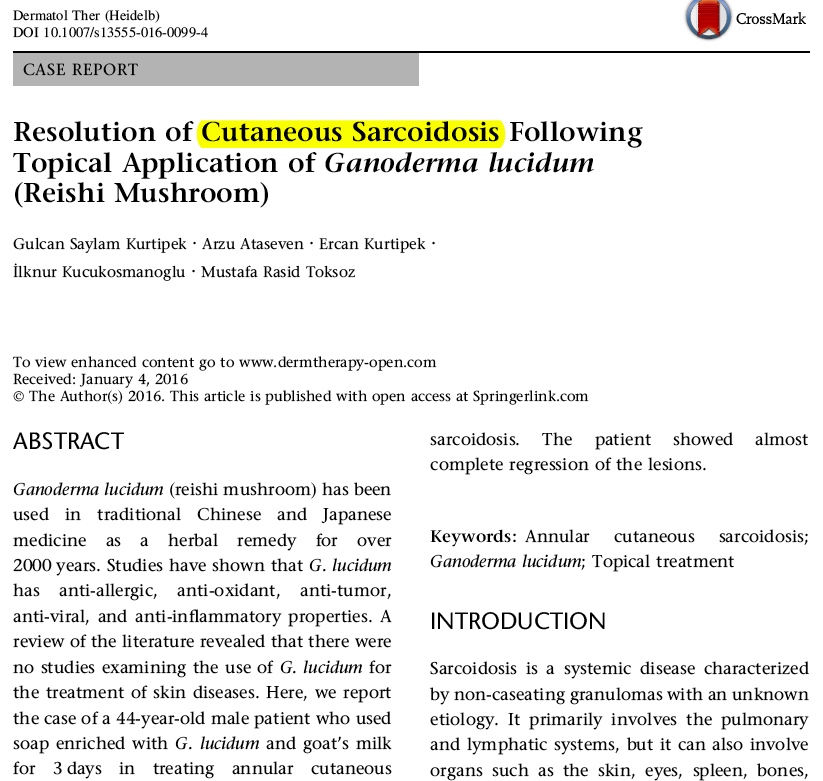February 11, 2016 / Konya Training and Research Hospital / Dermatologic Therapy
Text/Wu Tingyao

In February 2016, a report published by the Turkish Konya Training and Research Hospital in Dermatologic Therapy pointed out that the application of the medicated soap containing Ganoderma lucidum for a week helped a patient in a dermatology clinic improve the sarcoidosis of the scalp. This case showed the possibility of Ganoderma lucidum being applied to skin diseases. Whether the Ganoderma lucidum soap only for external use has this effect needs to be further clarified.
Sarcoidosis is an inflammatory disease in which granulomas, or clumps of inflammatory cells, form in various organs. This causes organ inflammation. Many inflammatory cells (including macrophages, epithelioid cells and multinucleated giant cells derived from macrophages) gather in a granuloma. A single granuloma is so small that it can only be seen under a microscope. As it gathers more and more, it will form large and small lumps that are visible to the naked eye.
Sarcoidosis can occur in any part of the body, especially in the lungs and lymphatic system. It also appears on the skin of one-third of patients. People who get this disease usually do not have symptoms in only one tissue or organ. The affected part may be painful, itchy, or scarred by ulcers, and it may also affect organ function.
Although the pathogenesis of sarcoidosis is not fully understood, immune factors are involved in the pathogenesis of sarcoidosis. Therefore, steroids, anti-inflammatory drugs or other immunosuppressants are usually used for treatment. Some people’s granulomas may shrink or disappear. Some people’s granulomas are always there, and the condition may change from time to time. Some people will have scars on the affected area and their organs will suffer permanent damage.
A report issued by this Turkish hospital stated that a 44-year-old man with sarcoidosis improved his skin symptoms by using medical soap containing Ganoderma lucidum. A dermatological examination showed that the patient’s skin had multiple plaque lesions of annular erythema with central atrophy and raised borders. After the tissue biopsy, the patient’s lesion inflammation and granuloma penetrated deep into the dermal tissue.
At first, he only had skin symptoms. Later, he was diagnosed with “bilateral hilar lymphadenopathy”, which is a typical symptom of pulmonary sarcoidosis in patients. After a period of regular treatment, the patient continued to return to the hospital to track his condition. During this follow-up visit, the patient stated that Ganoderma lucidum seemed to be helpful for the sarcoidosis on his scalp:
He applied medicated soap containing Ganoderma lucidum to the affected area every day, kept the soap foam on the lesion for 1 h, and then rinsed it. Three days later, those red lumps almost all subsided. Six months later, the lesion on the scalp recurred again, and he treated it with Ganoderma lucidum soap in the same way. The symptoms were relieved within a week.
The personal experience of this patient gave us an insight into the alternative applications of Ganoderma lucidum. In the past, many studies have confirmed that oral administration of Ganoderma lucidum can exert anti-allergic, anti-oxidant and anti-inflammatory effects, but why does Ganoderma lucidum medicated soap for external use work? This needs to be further clarified.
[Source] Saylam Kurtipek G, et al. Resolution of cutaneous sarcoidosis following topical application of Ganoderma lucidum (Reishi Mushroom). Dermatol Ther (Heidelb). 2016 Feb 11.
END
About the author/ Ms. Wu Tingyao
Wu Tingyao has been reporting on first-hand Ganoderma information since 1999. She is the author of Healing with Ganoderma (published in The People’s Medical Publishing House in April 2017).
★ This article is published under the exclusive authorization of the author.
★ The above works cannot be reproduced, excerpted or used in other ways without the authorization of the author.
★ Violation of the above statement, the author will pursue its related legal responsibilities.
★ The original text of this article was written in Chinese by Wu Tingyao and translated into English by Alfred Liu. If there is any discrepancy between the translation (English) and the original (Chinese), the original Chinese shall prevail. If readers have any questions, please contact the original author, Ms. Wu Tingyao.



